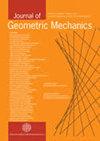Geometric optimal techniques to control the muscular force response to functional electrical stimulation using a non-isometric force-fatigue model
IF 1
4区 数学
Q3 MATHEMATICS, APPLIED
引用次数: 1
Abstract
A recent force-fatigue parameterized mathematical model, based on the seminal contributions of V. Hill to describe muscular activity, allows to predict the muscular force response to external electrical stimulation (FES) and it opens the road to optimize the FES-input to maximize the force response to a pulse train, to track a reference force while minimizing the fatigue for a sequence of pulse trains or to follow a reference joint angle trajectory to produce motion in the non-isometric case. In this article, we introduce the geometric frame to analyze the dynamics and we present Pontryagin types necessary optimality conditions adapted to digital controls, used in the experiments, vs permanent control and which fits in the optimal sampled-data control frame. This leads to Hamiltonian differential variational inequalities, which can be numerically implemented vs direct optimization schemes.利用非等距力-疲劳模型控制功能性电刺激下肌肉力响应的几何优化技术
最近的力-疲劳参数化数学模型,基于V. Hill描述肌肉活动的开创性贡献,允许预测外部电刺激(FES)的肌肉力响应,并为优化FES输入开辟了道路,以最大限度地提高对脉冲序列的力响应,跟踪参考力,同时最小化脉冲序列的疲劳,或遵循参考关节角度轨迹在非等距情况下产生运动。在本文中,我们引入几何框架来分析动力学,我们提出了适合于实验中使用的数字控制和永久控制的庞特里亚金类型的必要最优性条件,并适合于最优采样数据控制框架。这导致了哈密顿微分变分不等式,它可以通过直接优化方案在数值上实现。
本文章由计算机程序翻译,如有差异,请以英文原文为准。
求助全文
约1分钟内获得全文
求助全文
来源期刊

Journal of Geometric Mechanics
MATHEMATICS, APPLIED-PHYSICS, MATHEMATICAL
CiteScore
1.70
自引率
12.50%
发文量
23
审稿时长
>12 weeks
期刊介绍:
The Journal of Geometric Mechanics (JGM) aims to publish research articles devoted to geometric methods (in a broad sense) in mechanics and control theory, and intends to facilitate interaction between theory and applications. Advances in the following topics are welcomed by the journal:
1. Lagrangian and Hamiltonian mechanics
2. Symplectic and Poisson geometry and their applications to mechanics
3. Geometric and optimal control theory
4. Geometric and variational integration
5. Geometry of stochastic systems
6. Geometric methods in dynamical systems
7. Continuum mechanics
8. Classical field theory
9. Fluid mechanics
10. Infinite-dimensional dynamical systems
11. Quantum mechanics and quantum information theory
12. Applications in physics, technology, engineering and the biological sciences.
 求助内容:
求助内容: 应助结果提醒方式:
应助结果提醒方式:


